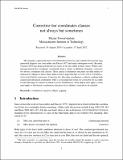Corrective but coordinates clauses not always but sometimes
Author(s)
Toosarvandani, Maziar
Download11049_2013_9198_ReferencePDF.pdf (685.7Kb)
PUBLISHER_POLICY
Publisher Policy
Article is made available in accordance with the publisher's policy and may be subject to US copyright law. Please refer to the publisher's site for terms of use.
Terms of use
Metadata
Show full item recordAbstract
The semantic contrast between counterexpectational and corrective but has long interested linguists (see Anscombre and Ducrot 1977 and much subsequent work). Recently, Vicente (2010) has proposed that the two types of but also differ in their syntax. While counterexpectational but coordinates constituents from a variety of different categories, corrective but always coordinates full clauses. These clausal coordination structures are then subject to reduction by ellipsis to derive their surface form. I argue that this clause-only coordination hypothesis is incorrect. Corrective but, like other coordinators, is able to combine both clausal and subclausal constituents. Only a crosscategorial syntax for corrective but accounts for the full range of contexts in which it occurs. Furthermore, when ellipsis does apply, it often must apply to subclausal coordination structures for its identity constraint to be satisfied.
Date issued
2013-06Department
Massachusetts Institute of Technology. Department of Linguistics and PhilosophyJournal
Natural Language & Linguistic Theory
Publisher
Springer Netherlands
Citation
Toosarvandani, Maziar. “Corrective but Coordinates Clauses Not Always but Sometimes.” Nat Lang Linguist Theory 31, no. 3 (June 25, 2013): 827–863.
Version: Author's final manuscript
ISSN
0167-806X
1573-0859